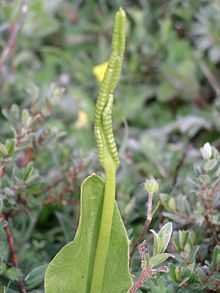Ophioglossum
| Ophioglossum | |
|---|---|
 | |
| Ophioglossum vulgatum | |
| Scientific classification | |
| Kingdom: | Plantae |
| Division: | Pteridophyta |
| Class: | Psilotopsida |
| Order: | Ophioglossales |
| Family: | Ophioglossaceae |
| Genus: | Ophioglossum L. |
| Species | |
|
Some 25-30, including: | |
Ophioglossum (adder's-tongue) is a genus of about 25-30 species of Ophioglossales in the family Ophioglossaceae, with a cosmopolitan but primarily tropical and subtropical distribution. The name Ophioglossum comes from the Greek, and means "snake-tongue".
Adders-tongues are so-called because the spore-bearing stalk is thought to resemble a snake's tongue. Each plant typically sends up a small, undivided leaf blade with netted venation, and the spore stalk forks from the leaf stalk, terminating in sporangia which are partially concealed within a structure with slitted sides. The plant grows from a central, budding, fleshy structure with fleshy, radiating roots. When the leaf blade is present, there is not always a spore stalk present, and the plants do not always send up a leaf, sometimes going for a year to a period of years living only under the soil, nourished by association with soil fungi.
Ophioglossum has the highest chromosome count of any known living organism, with 1,260 chromosomes.[1] In comparison, most species have far fewer chromosomes (e.g. humans have 46).
References
- ↑ Gerardus J. H. Grubben (2004). Vegetables. PROTA. p. 404. ISBN 978-90-5782-147-9. Retrieved 10 March 2013.